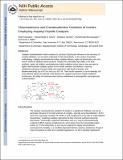Chemoselective and Enantioselective Oxidation of Indoles Employing Aspartyl Peptide Catalysts
Author(s)
Movassaghi, Mohammad; Noshi Alhanafy, Mohammad N.; Tjandra, Meiliana; Miller, Scott J.; Kolundzic, Filip
DownloadMovassaghi_Chemoselective and.pdf (2.570Mb)
PUBLISHER_POLICY
Publisher Policy
Article is made available in accordance with the publisher's policy and may be subject to US copyright law. Please refer to the publisher's site for terms of use.
Terms of use
Metadata
Show full item recordAbstract
Catalytic enantioselective indole oxidation is a process of particular relevance to the chemistry of complex alkaloids, as it has been implicated in their biosynthesis. In the context of synthetic methodology, catalytic enantioselective indole oxidation allows a rapid and biomimetic entry into several classes of alkaloid natural products. Despite this potentially high utility in the total synthesis, reports of catalytic enantioselective indole oxidation remain sparse. Here we report a highly chemoselective catalytic system for the indole oxidation that delivers 3-hydroxy-indolenines with good chemical yields and moderate to high levels of enantio- and diastereoselectivity (up to 95:5 er and up to 92:8 dr). These results represent, to our knowledge, the most selective values yet reported in the literature for catalytic asymmetric indole oxidation. Furthermore, the utility of enantioenriched hydroxy-indolenines in stereospecific rearrangements is demonstrated.
Date issued
2011-05Department
Massachusetts Institute of Technology. Department of ChemistryJournal
Journal of the American Chemical Society
Publisher
American Chemical Society
Citation
Kolundzic, Filip et al. “Chemoselective and Enantioselective Oxidation of Indoles Employing Aspartyl Peptide Catalysts.” Journal of the American Chemical Society 133.23 (2011): 9104–9111.
Version: Author's final manuscript
ISSN
0002-7863
1520-5126